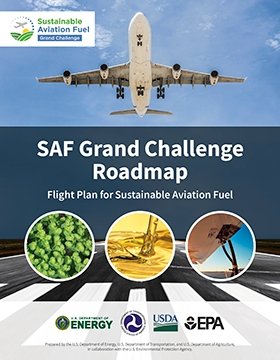
The Conversion Technology Innovation Action Area covers R&D through pilot scale from the receipt of biomass at the refinery gate through finished sustainable aviation fuel (SAF) to achieve technology improvements and carbon intensity reductions. The effort includes processes that are already commercialized, such as the hydroprocessed esters and fatty acids pathway, or nearing commercialization (e.g., the alcohol-to-jet [ATJ] pathway), and addresses work on processes that will be ready for commercialization beyond 2030 but need to be developed now. Workstreams between the Conversion Technology Innovation and Feedstock Innovation action areas will need to collaborate to ensure the delivery of feedstock suitable for conversion and conversion processes that maximize retainment of emissions reductions achievable through feedstock. Technology that is developed through integrated piloting is handed off to the Building Supply Chains area workgroups for regional supply chain demonstration projects.
Key Actions and Workstreams Supporting SAF Conversion Technology Innovation
|
Download the full version of the SAF Grand Challenge Roadmap: Flight Plan for Sustainable Aviation Fuel. |
- Improvements to fermentation fuel industry to reduce the carbon intensity of the existing starch ethanol industry and increase its production capacity without requiring the planting of additional corn.
- Improvements to existing ASTM-qualified pathways to accelerate deployment of pathways that have already been qualified.
- Development of biointermediates and pathways for compatibility with existing capital assets to accelerate production and reduce cost of SAF.
- Reduce scale-up and operational risk by proactively addressing resiliency in process and equipment design.
- Develop innovative unit operations and pathways to broaden the availability of SAF.
2030 Conversion Technology Innovation Impact Highlight
Enable Alcohol-to-Jet and Coprocessing Pathways
The existing corn ethanol industry has tremendous near-term potential to increase SAF production volumes through the ATJ pathway. Reducing the carbon intensity and increasing the carbon efficiency of corn ethanol are key barriers to realizing this potential. Activities under this workstream focus on improving the carbon intensity of existing corn ethanol facilities through carbon-smart technologies and agricultural practices. Additionally, dramatic improvements in water balances and energy intensity of the ATJ process are possible through development of water-tolerant catalysts and advanced separation technologies.
The utilization of bio-derived intermediates in existing capital assets may also contribute to the 2030 production goal. Developing processes to produce such intermediates that are "drop-in" substitutes for fats, oils, and greases or bio-oil in petroleum hydrotreaters, identifying insertion and blending points, and working with industry partners to determine critical material attributes of bio-derived intermediates are key examples of activities with potential impact on 2030 production goals.

